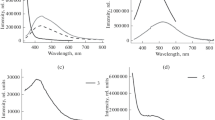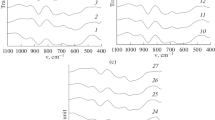Abstract
Bismuth-containing high-silica glass is synthesized by impregnating porous glass matrices in 0.01–0.5 M aqueous solutions of bismuth nitrate with the subsequent heat treatment at a temperature of 50–875°C. The dependences of the spectral-optical properties of the synthesized glass on the concentration of the doped bismuth (0.02–1.17 wt % Bi2O3) and heat treatment temperature are studied. It is found using the method of optical spectroscopy that bismuth is present in glass in different oxidation states—Bi3+, Bi2+, and \(\rm{Bi_5^{3+}}\) clusters. Near infrared spectroscopy in the 7500–4000 cm–1 frequency range reveals that an increase in the temperature results in a gradual decrease in the intensity of the absorption bands due to the vibration of hydroxyl groups and water molecules adsorbed on the surface. The glasses (T ~ 50 and 400°C) exhibit bands at 4445–4443, 4433, and 4417–4415 cm–1, which correspond to the absorption of Bi+ ions.
Similar content being viewed by others
References
Firstov, S.V., Ryumkin, K.E., Khopin, V.F., Alyshev, S.V., Firstova, E.G., Mel’kumov, M.A., Gur’yanov, A.N., and Dianov, E.M., Anti-Stokes luminescence in bismuth-doped aluminoand phosphosilicate fibres under two-step IR excitation, Quantum Electron., 2016, vol. 46, no. 7, pp. 612–616.
Vtyurina, D.N., Romanov, A.N., Zaramenskikh, K.S., Vasil’eva, M.N., Fattakhova, Z.T., Trusov, L.A., Loiko, P.A., and Korchak, V.N., IR luminescence of bismuth-containing centers in materials prepared by impregnation and thermal treatment of porous glasses, Russ. J. Phys. Chem. B, 2016, vol. 10, no. 2, pp. 211–214.
Firstov, S.V., Girsova, M.A., Dianov, E.M., and Antropova, T.V., Luminescent properties of thermoinduced active centers in quartz-like glass activated by bismuth, Glass Phys. Chem., 2014, vol. 40, no. 5, pp. 521–525.
Girsova, M.A., Synthesis, structure and spectral-optical properties of composite materials based on silicate porous glasses containing silver halides or bismuth oxides, Cand. Sci. (Chem.) Dissertation, St. Petersburg, 2015.
Marzouk, M.A. and ElBatal, F.H., UV-visible and infrared absorption spectra of Bi2O3 in lithium phosphate glasses and effect of gamma irradiation, Appl. Phys. A, 2014, vol. 115, no. 3, pp. 903–912. doi 10.1007/s00339-013-7887-9
Khonthon, S., Morimoto, S., Arai, Y., and Ohishi, Y., Redox equilibrium and NIR luminescence of Bi2O3-containing glasses, Opt. Mater., 2009, vol. 31, no. 8, pp. 1262–1268.
Hashimoto, T., Shimoda, Y., Nasu, H., and Ishihara, A., ZnO-Bi2O3-B2O3 glasses as molding glasses with high refractive indices and low coloration codes, J. Am. Ceram. Soc., 2011, vol. 94, no. 7, pp. 2061–2066. doi 10.1111/j.1551-2916.2010.04383.x
Antropova, T.V., Girsova, M.A., Anfimova, I.N., Golovina, G.F., Kurilenko, L.N., and Firstov, S.V., Production method of luminescent bismuth-containing quartz-like material based on high-silica porous glass, RF Patent No. 2605711, Byull. Izobret., 2016, no.36.
Girsova, M.A., Firstov, S.V., and Antropova, T.V., Structural and optical properties of the bismuth-containing quartz-like glasses, J. Phys.: Conf. Ser., 2014, vol. 541, p. 012022. doi 10.1088/1742-6596/541/1/012022
Girsova, M.A., Firstov, S.V., Anfimova, I.N., Golovina, G.F., Kurilenko, L.N., Kostyreva, T.G., Polyakova, I.G., and Antropova, T.V., High-silica glasses doped with bismuth, Fiz. Khim. Stekla, 2012, vol. 38, no. 6, pp. 861–863.
Girsova, M.A., Golovina, G.F., Kurilenko, L.N., Antropova, T.V. Synthesis and study of bismuth-containing high-silica glass by the IR spectroscopy method, Glass Phys. Chem., 2015, vol. 41, no 1, pp. 93–97.
Zhou, S., Jiang, N., Zhu, B., Yang, H., Ye, S., Lakshminarayana, G., Hao, J., and Qiu, J., Multifunctional bismuth-doped nanoporous silica glass: from bluegreen, orange, red, and white light sources to ultrabroadband infrared amplifiers, Adv. Funct. Mater., 2008, vol. 18, no. 9, pp. 1407–1413.
Fan, X., Su, L., Ren, G., Jiang, X., Xing, H., Hu, J., Tang, H., Li, H., Zheng, L., Qian, X., and Feng, H., Influence of thermal treatment on the near-infrared broadband luminescence of Bi:CsI crystals, Opt. Mater. Express, 2013, vol. 3, no. 3, pp. 400–406.
Romanov, A.N., Fattakhova, Z.T., Veber, A.A., Usovich, O.V., Haula, E.V., Korchak, V.N., Tsvetkov, V.B., Trusov, L.A., Kazin, P.E., and Sulimov, V.B., On the origin of near-IR luminescence in Bi-doped materials (II). Subvalent monocation Bi+ and cluster Bi5 3+ luminescence in AlCl3/ZnCl2/BiCl3 chloride glass, Opt. Express, 2012, vol. 20, no. 7, pp. 7212–7220.
Hamstra, M.A., Folkerts, H.F., and Blasse, G., Red bismuth emission in alkaline-earth-metal sulfates, J. Mater. Chem., 1994, vol. 4, no. 8, pp. 1349–1350.
Little, L.H., Infrared Spectra of Adsorbed Molecules, London: Academic, 1966.
Kiryutenko, V.M., Kiselev, A.V., Lygin, V.I., and Shchepalin, K.L., Study of the surface properties of porous glass by infrared spectroscopy, Kinet. Katal., 1974, vol. 15, no. 6, pp. 1584–1588.
Gavrilko, T., Gnatyuk, I., Puchkovska, G., Baran, J., Marchewka, M., and Morawska-Kowal, T., Application of NIR spectroscopic method to the study of porous glasses filled with liquid crystals, Opt. Appl., 2003, vol. 33, no. 1, pp. 23–32.
Schmidt, B.C., Effect of boron on the water speciation in (alumino)silicate melts and glasses, Geochim. Cosmochim. Acta, 2004, vol. 68, no. 24, pp. 5013–5025. doi 10.1016/j.gca.2004.06.036
Zotov, N. and Keppler, H., The influence of water on the structure of hydrous sodium tetrasilicate glasses, Am. Mineralog., 1998, vol. 83, nos. 7–8, pp. 823–834.
Bauer, U., Behrens, H., Reinsch, S., Morin, E.I., and Stebbins, J.F., Structural investigation of hydrous sodium borosilicate glasses, J. Non-Cryst. Solids, 2017, vol. 465, pp. 39–48.
Davis, K.M., Agarwal, A., Tomozawa, M., and Hirao, K., Quantitative infrared spectroscopic measurement of hydroxyl concentrations in silica glass, J. Non-Cryst. Solids, 1996, vol. 203, pp. 27–36.
Wu, C.-K., Nature of incorporated water in hydrated silicate glasses, J. Am. Ceram. Soc., 1980, vol. 63, nos. 7–8, pp. 453–457.
Plotnichenko, V.G., Philippovskiy, D.V., Sokolov, V.O., Golovanov, V.F., Polyakova, G.V., Lisitsky, I.S., and Dianov, E.M., Infrared luminescence in bismuth-doped AgCl crystals, Opt. Lett., 2013, vol. 38, no. 16, pp. 2965–2968. https://doi.org/10.1364/OL.38.002965
Author information
Authors and Affiliations
Corresponding author
Additional information
Original Russian Text © M.A. Girsova, G.F. Golovina, I.N. Anfimova, L.N. Kurilenko, 2018, published in Fizika i Khimiya Stekla.
Rights and permissions
About this article
Cite this article
Girsova, M.A., Golovina, G.F., Anfimova, I.N. et al. Properties of Bismuth-Containing High-Silica Glass Depending on the Bismuth Concentration and Heat Treatment. I. Spectral-Optical Properties. Glass Phys Chem 44, 381–387 (2018). https://doi.org/10.1134/S1087659618050061
Received:
Published:
Issue Date:
DOI: https://doi.org/10.1134/S1087659618050061




